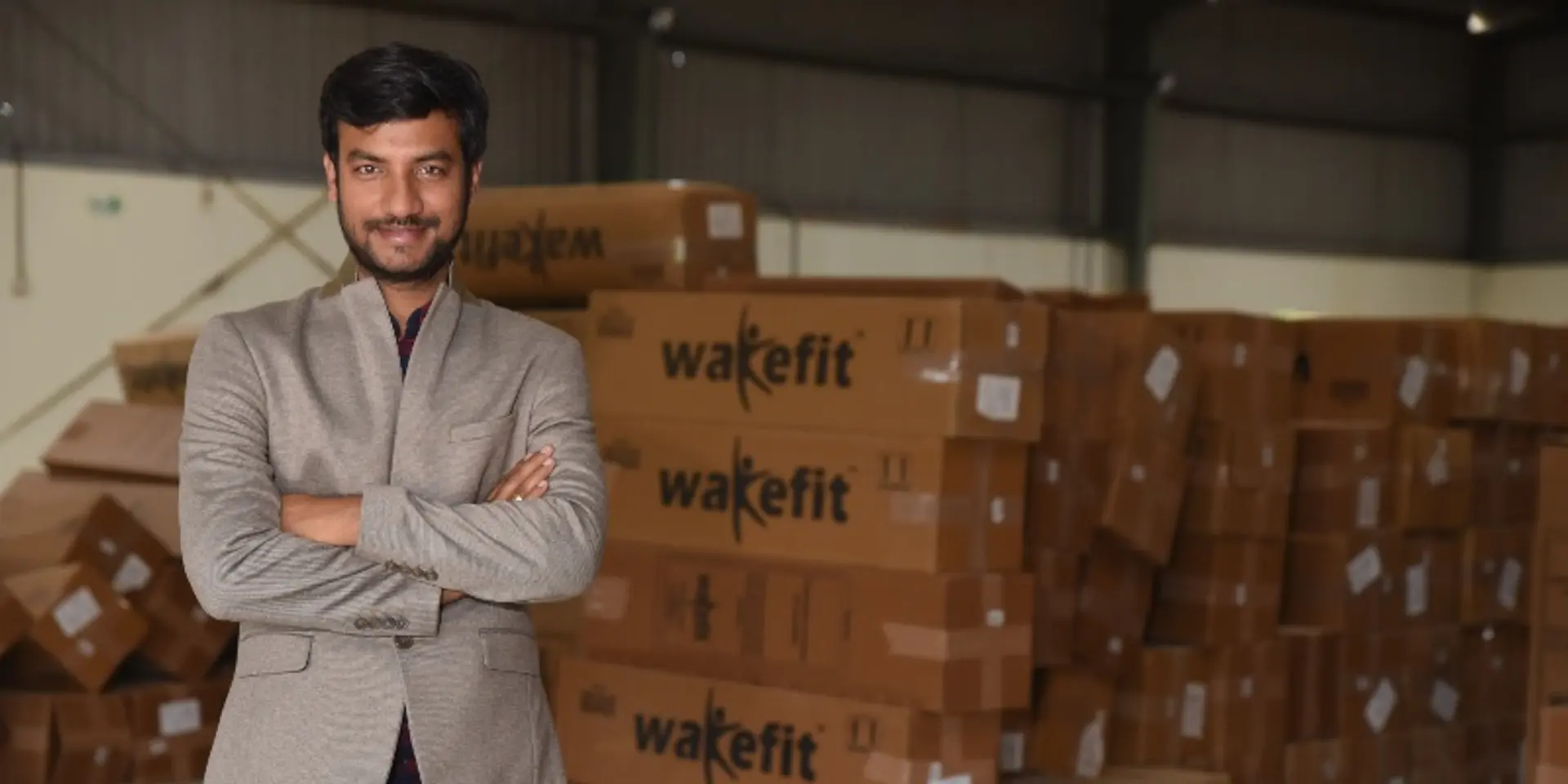How D2C startup Wakefit saw 2X rise in revenue amid COVID-19
D2C startup Wakefit clocked revenue of Rs 410 crore in FY21, a 2X growth from FY20. Here's how the Bengaluru-based sleep and home solutions startup managed to achieve this.
In FY21, Sequoia-backed D2C startup Wakefit recorded 2X growth, clocking Rs 410 crore revenue. The year earlier, it registered a turnover of Rs 197 crore.
Founded in 2016 by Chaitanya Ramalingegowda and Ankit Garg, the direct-to-consumer startup started by offering premium mattresses at affordable prices. Eventually, it launched sleep accessories like back pillows, neck support pillows, comforters, etc.
Since its inception, Wakefit claims to be seeing its EBITDA touch around 10 percent year on year. In its first year of operation, the startup recorded Rs 6.75 crore revenue. In FY18, it raked in Rs 27 crore and touched Rs 81 crore in FY19.
"Our product innovation and customer-centric DNA have enabled us to achieve 2-2.5X revenue growth year-on-year. We have been profitable every year since inception, and we have a deep focus on balancing profitability with a healthy growth trajectory,” Wakefit CEO Ankit tells YourStory.
According to Chaitanya, the startup has been able to achieve profitability and EBITDA growth by focusing on backward integration, significantly reducing the cost of production and raw materials.
The full-stack company manufactures all its products in-house across nine factories in Bengaluru, Jodhpur, and Delhi. It also has over 22 experience centres — six in metros and nine in smaller towns.

Chaitanya Ramalingegowda
A new range and new markets
Amid the COVID-19 pandemic, Wakefit pivoted to the home solutions space. Besides its flagship mattresses and sleep accessories, the startup expanded to include a range of ergonomic furniture, including sofas, study tables, bookshelves, shoe racks, TV units, bedside tables, coffee tables, dining tables, and more.
“Adding furniture was always on the cards but the pandemic pushed us to launch this earlier,” says Chaitanya.
Today, the furniture segment contributes 20 percent to Wakefit’s revenue. “People are at home, and they are investing in their homes, which contributes to our revenue,” he adds.
Last year, the startup invested in machinery and factories and aims to boost its manufacturing capability in the next nine to 12 months.
During this period, Wakefit also turned its focus towards Tier II and III markets. Chaitanya claims that close to 50 percent of the startup’s revenue comes from Tier II and III markets. Earlier, this was at 35 percent.
“Most of this has been organic growth. Last year, many people went back to their hometowns. The same tech-savvy people were now ordering from different parts of India. The market is a little different — they aren’t as experimental as consumers in metro cities. They start with well-known products and then graduate to others,” he explains.
After this success, the startup aims to further expand in these locations.
“The idea is to continue investing in Indian language content. In these 12 months, we have opened more experience centres as well. Markets that are growing include Aurangabad, Tirupur, smaller towns in Uttarakhand, Indore, Amaravati, etc.,” Chaitanya says.
It also launched ‘Wakefit Gurukul’, where it has trained over 200 carpenters to build home solution products. This, he adds, was important as they realised that installation became an issue once they went live in different cities.
“Also, carpenters in small towns don’t have the right skills, and there were many cases of misbehaviour. We were always passionate about skilling, so we thought why not merge the two and start Wakefit Gurukul,” the co-founder explains.
These semi-skilled and unskilled labourers undergo a three-month training programme and are paid a salary between Rs 18,000 and Rs 25,000.
Depending on the number of installations, the carpenters also receive variable pay, ensuring a steady paycheque. As a part of this, Wakefit has worked with over 800 customer saving executives and machine operators.
Deep focus on R&D
At the core of Wakefit's R&D process lies insights gathered from its customers.
For instance, its initial product — the Wakefit Orthopedic Memory Foam Mattress — is designed to have seven differential zones that cater to the support needs of different body parts.
“Similarly, all our furniture has been engineered with a focus on the science of ergonomics to ensure our bodies get the right support and alignment wherever we choose to spend our time in our homes,” says Ankit.
To ensure a robust supply chain and distribution in every corner of India, Wakefit works with multiple logistics partners with unique strengths in diverse geographies.
"This is augmented with our warehouse and logistics infrastructure. We are servicing over 19,000 pin codes across India and aim to deliver to more customers in deeper pockets of the country,” says Ankit.
Customer is the king
While most companies focus on building a customer relationship during a sale, Wakefit strives towards deepening those relationships even after the sale. For this, it keeps an ongoing process of open communication.
As a digitally native company, all of Wakefit’s order fulfilment and customer delight processes are technology-enabled. "Further, a robust ERP system gives us good control of the overall health of the business,” adds Ankit.
However, it was tough for the startup to ensure customer satisfaction, especially during the first wave, when many norms were unclear. Micro-blogging platform Twitter was one of the most common spots where customers had multiple queries. In fact, many also severely criticised the brand.
But, Wakefit was quick to resolve their issues. In many instances, Chaitanya also took to the social media platform to respond to queries while the team started solving the snags behind the scenes.
“We work proactively, talk to the customers to understand if they are aware of the terms of the usage, how to improve longevity, etc. This relationship isn’t that of any other seller,” Chaitanya says.
Adding, “Another factor is focussing on frugal marketing campaigns and not traditional advertising. For instance, we launched a sleep internship, which brought awareness around the brand and the solutions we wanted to bring.”
Working around different challenges
During the first few years of operations, Wakefit’s primary challenge was to build customer trust since it was new in the market.
The notion of shopping online for mattresses and other sleep and home solutions was a novel concept, which needed awareness and education to drive customer adoption.
“We developed our brand promises based on on-ground research, which included a 100-day trial policy with 100 percent refund, doorstep delivery, EMI options, and more. These promises — coupled with our innovation in the material sciences — helped us build customer trust and loyalty. Today, we have more than one lakh verified positive customer reviews across online platforms,” says Ankit.
This, Ankit explains, helps the brand innovate products and keep its prices reasonable while being able to maintain healthy financial records.
In 2018, the startup raised Rs 65 crore in a Series A round from Sequoia Capital India. Two years later, in December 2020, it raised Rs 185 crore in Series B investment led by Europe-based Verlinvest and Sequoia. At present, Wakefit’s valuation stands at Rs 1,900 crore.
Chaitanya says the startup is in talks to raise fresh funds but doesn't disclose any details.

“Form follows function” is one of the main principles associated with design.
The online world of furniture
Commenting on the consumer economy, Anil Kumar, Co-founder and CEO, RedSeer, said,
“2020 has truly been a landmark year for India’s consumer internet economy. Overall, India Internet GMV grew to $65 billion in 2020 and is now creating a large impact on the overall economy — with almost 4.6 percent of total private consumption coming from India Internet."
“We expect India Internet to accelerate further in 2021, driven by massive growth in consumer adoption and satisfaction in 2020 across sectors — with India Internet expected to cross triple digits GMV for the first time in 2021, and eventually become $250 billion scales and 10 percent of private consumption in 2025,” he adds.
As per industry estimates, the Indian mattress market — worth $1.7 billion in 2018 — is expected to grow at a CAGR of 10 percent to reach $2.5 billion by 2022. A substantial share of the increased demand is expected to come from Tier II and III cities.
A 2020 RedSeer report states that the Indian online furniture segment is pegged at $16 billion, growing at a CAGR of 15-17 percent on the back of increased digitisation, newer business models, and rapid urbanisation. In fact, the online furniture industry in India constitutes only 15 percent of the organised market, growing bullishly at 80-85 percent.
This shift is also because online-first (D2C) brands have gained over 30 percent share of ecommerce, which will grow to 45 percent by 2025.
Talking about the future, Ankit says, “At Wakefit, we aim to become a one-stop-shop for all sleep and home solutions in India. Our future plans entail strengthening the brand and ramping up production capabilities and distribution networks across Indian markets.”
He adds, “This year, we are excited to set up experience centres in a few cities, including Bengaluru, Hyderabad, Coimbatore, Lucknow, and Gurugram. This is in response to growing customer feedback to allow them to experience the look and feel of the products in the new range before purchasing them.”
Edited by Suman Singh



![[HS Conversations] With former Victoria’s Secret CEO on board as advisor, homegrown lingerie brand Clovia eyes global expansion](https://images.yourstory.com/cs/4/a9efa9c02dd911e9adc52d913c55075e/Imageocb7-1623819230424.jpg?fm=png&auto=format&h=100&w=100&crop=entropy&fit=crop)
![[Product Roadmap] How CleverTap used AI and ML to help Nykaa, Zomato, AirAsia, and Dream 11 engage users](https://images.yourstory.com/cs/2/a9efa9c02dd911e9adc52d913c55075e/Product-Roadmap-1623767830740.png?fm=png&auto=format&h=100&w=100&crop=entropy&fit=crop)





